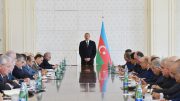Under Catherine II, Russia’s struggle for the Caucasus was carried out purposefully. By signing the Treaty of Küçük Kaynarca (1774), Russia has strengthened its positions in the Crimea and the Azov coast, and thereby expanded its sphere of influence in the mega region – Caucasus. Catherine II, in order to establish its political domination in this choronym, had been conducting an active resettlement policy. In so doing, just like her forefather, she has not refused to play the “Armenian card”. The Highest Charter of March 9, 1779, by the Russian Empress gave rise to the Armenian colonization of the Don coast. Nakhichevan city was established on the outskirts of the St. Demetrius of Rostov Fortress and Russia resettled 20 thousand Armenians from Crimea, including the newly formed city of Novorossiysk province. Active efforts of representatives of the wealthier segments of Armenians contributed to this colonization. In the XVIII century, rich Armenian merchants, natives of New Julfa, who left the Safavid state during its fall, appear in Russia. Sparing no expense, they set the Armenian tandem in motion. The Sarafovs and Lazarevs made a special effort in this direction. Ivan Lazarev was especially distinguished. By turning into a major industrialist and landowner in the Russian Empire as a result of successful commercial and financial deals, he invested huge subsidies in imposing intelligible dreams of the Armenians among the highest circles of Russian society. Stressing the primary role of the Armenian Gregorian Church, the carrier of mythical idea of “Great Armenia”, this Armenian wealthy man, in the last quarter of the XVIII century, built Armenian churches in the capital cities of the Russian Empire. Ivan Lazarev became one of the key “players”, who integrated the “Armenian question” into the policy of Catherine’s Russia. By entering into negotiations with the famous favorite of Catherine II Prince G. Potemkin, this wealthy Armenian, in unison with the head of the Armenian Church in Russia Archbishop Joseph Argutinsky, tried to convince the Russian nobleman in feasibility of the formation of the Armenian statehood with the center in Irevan, while not recalling the historical homeland of the Armenians, located on the banks of the Euphrates, and which has no relation to the Caucasus, and thus, to Irevan. The duo of Lazarev- Argutinsky, in the presented draft, insisted on capturing of this ancient Azerbaijani city by the Russian army. Short memory of the Armenian tandem during the creation of this project has “failed” and it “forgot” about the pre-Caucasus homeland of Armenians – Eastern Anatolia.
In the second half of the XVIII century, the Armenian statehood projects have been also developed by rich Armenians of Indian colonies. The authors of projects – Joseph Emin, Sh. Shaamiryan tried to draw the attention of Catherine’s Russia to the centuries-old dream of Armenians. These designers of “Great Armenia”, as well as their predecessors, considered it appropriate to act in union with the Kingdom of Kartli-Kakheti. Presenting projects identical in content, the representatives of the Indian colonies, in order to achieve their intelligible dream, just like their fellow-designers of Russian colonies, “forgot” the original oecumene, Asia Minor, which served as the matrix in the process of formation of the Armenian statehood and, by creating virtual geographic framework of their centuries-old dream, set their sights on foreign soil, on the ancestral lands of Azerbaijan.
Hajar Verdiyeva Doctor of Historical Science



Be the first to comment at "Azerbaijan in the context of Caucasus policy of the Russian Empire: from Peter to Pavel Part II"